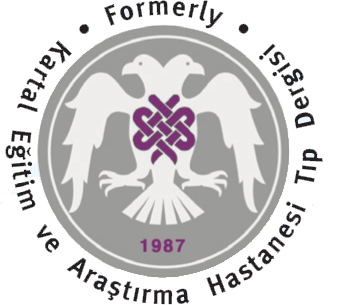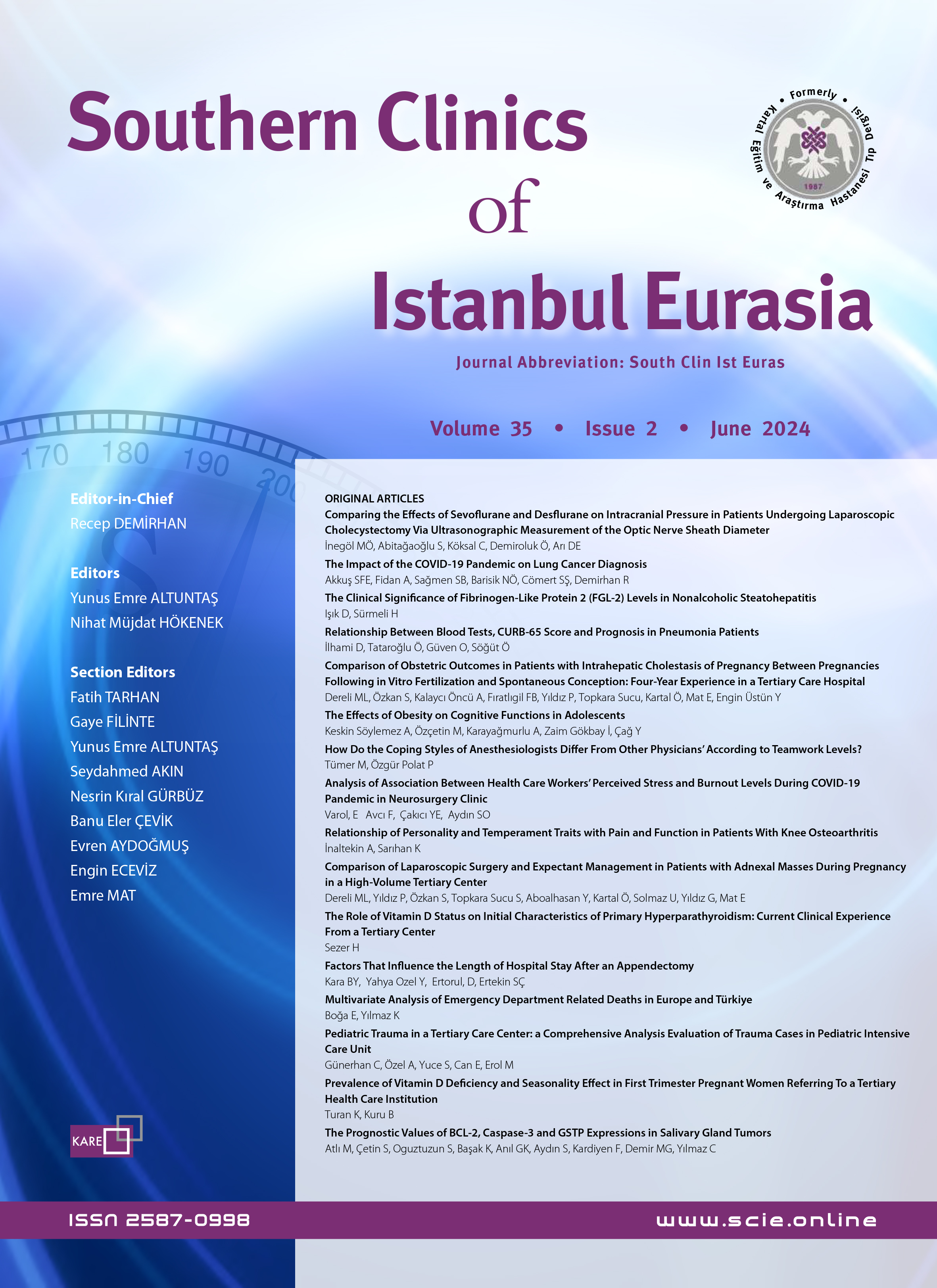Volume: 16 Issue: 3 - 2005
| RESEARCH ARTICLE | |
| 1. | Traumatıc Dıaphragm Injurıes Fazlı Cem Gezen, Selahattin Vural, Mustafa Öncel, Feyyaz Onuray, Alpay Örki, Erhan Tunçay, Engin Baştürk, Bayça Taşkara, Cengiz Menteş Pages 117 - 121 OBJECTIVE: Traumatic diaphragm rupture is a pathology causing diagnostic problem since it is often missed at the time of evaluation and treatment of traumatic diaphragm rupture may result in difficulties due to the concomitant organ injuries. In this retrospective study, the patients with traumatic diaphragm injuries admitted and treated in our clinic between 1997 and 2003 were analyzed for demographics, types of the traumas, concomitant injuries, treatment modalities and the rate and causes of the mortality. Diaphragm repair was performed in 45 patients (41 males; median age 26.35±8.07 years). Blunt and penetrating injuries were determined in 12 and 33 patients (14 gunshot injury and 19 penetrating injury), respectively. Liver (n=18, 40%) and spleen (n=16, 35.5%) were the most commonly injured organs concomitantly. Isolated diaphragm injuries were seen in only 4 cases (8.9%). The injuries were generally diagnosed at the time of laparotomy due to neighbor organ injuries (n=37, 82.2%). The diaphragm ruptures were preoperatively diagnosed with computerized tomography (n=3, 6.7%), diagnostic peritoneal lavage (n=3, 6.7%) and chest X-ray (n=2, 4.4%). The injuries were classified as grade 2 (n=10, 22.2%), 3 (n=26, 57.7%) or 4 (n=9, 20%) according to Moore organ injury scaling. The repairs of the diaphragm were performed with primary sutures and via transabdominal approach in all patients. However, thoracotomy was required in 3 cases (6.7%) in order to correct pulmonary injuries. Mortality was seen in 4 patients (8.9%). Traumatic diaphragm ruptures are pathologies generally accompanied by neighbor organ injuries, possibly causing diagnostic and treatment problems and resulting mortalities not infrequently. In our opinion, transabdominal approach is a convenient management option for the emergent cases. The continuity of the diaphragm should be checked in every laparotomy performed due to trauma. METHODS: RESULTS: CONCLUSION: |
| 2. | Results Of Cataract Surgery In Monocular Patıents Arzu Taşkıran Çömez, Yelda Buyru Özkurt, Levent Akçay, Ömer Kamil Doğan Pages 122 - 126 OBJECTIVE: In this study, the change in visual acuity and complications occurred after cataract surgery in monocular patients were assessed. The records of 29 monocular patients who underwent phacoemulsification or extracapsular cataract surgery (ECCE) with posterior chamber intraocular lens (PC IOL) implantation were reviewed retrospectively. Total 29 patients (4 female, 25 male) with a mean age of 76.8 were followed up for mean 21 months. Postoperative visual acuity (VA) improved 2 lines or under in 17 patients and 3 lines and over in 10 patients but VA did not change in 2 patients. When the preoperative history of the monocular patient and the reasons for the negative light perception of the unoperated eye were taken into consideration and necessary measures were taken during careful surgery, the complication rate of extracapsular cataract surgery (ECCE) will decrease and the results of the surgery and the final visual acuity will be satisfactory both for the patient and the doctor. METHODS: RESULTS: CONCLUSION: |
| 3. | Comparıson Of Fentanyl And Sufentanıl Added To Hyperbarıc Bupıvacaıne For Spınal Anesthesıa Yaman Özyurt, Hakan Erkal, Gülten Arslan, Selda İtez, Zuhal Arıkan Pages 127 - 131 OBJECTIVE: Subarachnoid block is a widely used anaesthesia technique for transurethral resection of prostate. Its quality can be improved with addition of opioids to the local anesthetics. In this study, we aimed to compare effects of 2.5 mg sufentanil or 25 mg fentanyl combined with hyperbaric bupivacaine used via intrathecal route in patients undergoing transurethral resection of the prostate on quality of spinal anesthesia and haemodynamic parameters. This was a prospective, randomized, controlled trial with 60 patients, ASA I-II, who were scheduled for elective transurethral resection of the prostate under subarachnoid block. Patients were allocated into three groups: no opioid (Group K), 2.5 mg sufentanil (Group S) and 25 mg fentanyl (Group F). In all groups, hyperbaric bupivacaine 0.5% (12.5 mg) was used as local anesthetic and the total volume of solution was 4 ml. The onset time of block, maximum level of sensory block, motor block level, duration of analgesia, side effects were evaluated. Onset of the block was significantly shorter in the groups receiving opioids compared with the control group. Analgesia time was significantly prolonged in Groups S and F. There was not any statistical difference between groups on effects of cardiovascular and respiratory systems. The occurrence of pruritus was significantly higher in group receiving sufentanil 2.5 mg than in other groups. The addition of sufentanil 2.5 mg and 25 mg fentanyl to hyperbaric bupivacaine provided adequate anesthesia for transurethral resection of the prostate and good postoperative analgesia. METHODS: RESULTS: CONCLUSION: |
| 4. | Stoma Complıcatıons In Ten Years Gülay Dalkılıç, Cengiz Menteş, Murat Çalıkapan, Feyyaz Onuray, Hakan Acar, Canan Arslan, Selahattin Vural Pages 132 - 135 OBJECTIVE: We aimed to evaluate the stoma practices performed frequently in our clinic. The stoma complications lead to psychological problems in the patients. In this study, 102 patients (54 males [52.9%], 48 females [47.1%]) with stomas were analyzed for mortality and morbidity. Two patients who had jejunostomy for nutritional jejunostomy have died because of sepsis due to intraabdominal leak from the stoma. Necrosis was seen in 4 patients. Retraction was found in 11 patients. Wound infection and skin irritation around stoma were observed in 11 and 38 patients, respectively. Mortality and morbidity of stomas may be decreased with the right indications and meticulous surgical techniques. METHODS: RESULTS: CONCLUSION: |
| 5. | The Effect Of Intravıtreally Admınıstered Trıamcınolone Acetonıde On Anatomıc And Vısual Prognosıs In Dıffuse Dıabetıc Macular Edema Resıstant To Photocoagulatıon İbrahim Arif Koytak, Yasin Yılmaz, Ekrem Kurnaz, Burak Özdemir, Yusuf Özertürk Pages 136 - 142 OBJECTIVE: To assess the effect of intravitreally administered triamcinolone acetonide on anatomic and visual prognosis in diffuse diabetic macular edema resistant to photocoagulation was aimed in this study. 4 mg/0.1 ml triamcinolone acetonide was injected intravitreally to thirty-nine eyes of thirty diabetic patients aged between 52 and 75. All eyes had a previous history of at least one session of laser photocoagulation. The fundus fluorescein angiographic and visual results of all cases were recorded in the first, third and sixth months after the injection. The best corrected visual acuities of the eyes were measured 0.35±0.16, 0.38±0.18 and 0.32±0.16 in first, third and sixth months respectively. The mean improvement of the best corrected visual acuities were found to be 0.13±0.12 in the first month, 0.17±0.12 in the third, and 0.11±0.11 in the sixth month. Twenty-five eyes (64.1%) showed marked improvement in fundus fluorescein angiographic findings while fourteen eyes (35.9%) showed no improvement. The mean intraocular pressure which was 15.38±2.40 mmHg before the treatment, was found to be increased 24.2% in the first month, 14.1% in the third and 12.2% in the sixth month after the treatment. Intraocular pressure was measured above 21 mmHg in 12 cases, all who responded well to topical monotherapy. Intravitreally administered triamcinolone acetonide was found to be an easy and low-cost agent with an acceptable rate of complications, which temporarily yields anatomic and visual improvements in diffuse diabetic macular edema cases resistant to photocoagulation. METHODS: RESULTS: CONCLUSION: |
| 6. | Surgıcal Treatment Of Congenıtal Pes Equınovarus That Cannot Be Corrected By Conservatıve Methods Güven Bulut, Gökçe Mik, Gültekin Çeçen, Erman Yanık, Muzaffer Yıldız Pages 143 - 146 OBJECTIVE: Congenital pes equinovarus (PEV) cases, who are late admitted or conservative treatment was unsuccessful, are surgically treated. Since early surgical treatment induces fibrosis, scar formation and joint stiffness; it is necessary to delay surgery at least for 3 months. Twenty-four feet of 15 patients diagnosed as congenital PEV and treated conservatively by Kite method but not corrected completely were treated surgically in our clinic during 1997-2001. Mean age of the patients was 11 (range, 6-36) months. Four patients were female and 11 patients were male. 10 patients had bilateral PEV while 3 had in left hand side and 2 had in right hand side. 16 feet were treated by complete subtalar release (CSTR), 4 by posteromedial release and 4 by achiloplasty. Mean follow-up period of the patients was 36 (range, 10-84) months. When the results were evaluated according to Simons criteria, there were 19 (79%) successful, 5 (21%) unsuccessful results. There were 2 skin necrosis healed by wound care without no requirement for secondary intervention. Four cases with unsuccessful results were treated by CSTR and 1 case was treated by posteromedial release. Although having some complications such as wound problems, over correction, etc; CSTR is the most favorable surgical procedure as we preferred in our most patients. METHODS: RESULTS: CONCLUSION: |
| 7. | Evaluation of 25 consequitive patients undergone Whipple procedure Hasan Fehmi Küçük, Levent Kaptanoğlu, Hüseyin Uzun, Hüseyin Akyol, Oğuzhan Aziz Torlak, Elif Çolak, Necmi Kurt Pages 147 - 152 OBJECTIVE: Although the mortality rate of pancreaticoduodenectomy, that is a complex operation, has decreased recent years the morbidity rate is still high. The aim of this study is to evaluate the outcome of the patients undergone pancreaticoduodenectomy. METHODS: The number of patients undergone Whipple procedure, between 2002 and 2005 was twenty five. RESULTS: There was no operative mortality (0%). The morbidity rate was 36%. The pancreaticojejunal fistula rate was 8%. The median survival duration was 17 months in patients with malign neoplasm of head and periampullary region of the pancreas. CONCLUSION: The surgeons should not hesitate to perform pancreaticoduodenectomy whenever indicated. However this operation should be performed in experienced centers because of the complexity of the operation and patients should be evaluated with multidisciplinary pattern. |
| CASE REPORT | |
| 8. | Stress-Related Mucosal Dıseases In Crıtıcally Ill Patıent Banu Çevik, Ayşegül Çizen, Arzum Örskıran, Erhan Çıplaklıgil, Elif Bombacı, Serhan Çolakoğlu Pages 153 - 157 Critically ill patients have increased risk for stress-related gastrointestinal hemorrhage. These hemorrhages can be clinically important which are associated with increased mortality and morbidity. Stress ulcer prophylaxis are used in these patients but has not been shown to improve survival. We reported two cases that died due to massive gastrointestinal bleeding in spite of stress ulcer prophylaxis. |
| 9. | A Case Of Prımary Antıphospholıpıd Syndrome Presentıng Wıth Ascıtes Ahmet Akın, Songül Aktaş, Didem Aydın, Hasan Kılıç, Özgür Keşkek, Rahmi Irmak Pages 158 - 160 Antiphospholipid syndrome is a hypercoagulable state characterized by recurrent venous and/or arterial thrombosis and/or pregnancy complications of fetal loss in the presence of antiphospholipid antibodies. Often it is seen in association with autoimmune connective tissue disorders like systemic lupus erythematosus (SLE). It may be seen in presence of infections, malignancies and drugs. Antiphospholipid syndrome (APS) is diagnosed by measuring antiphospholipid antibodies in patients with vascular thrombosis and/or repeated abortions in pregnancy. Thromboses are observed in all of the vascular system from aorta to precapillary arteriole, however mainly in lower extremities and cranial veins. Depending on the localization of the thromboses, it may display a wide range of clinical spectrum. A patient who presented with ascites to our clinic was diagnosed as primary antiphospholipid syndrome. Since it is a rare case, we present this case here. |
| REVIEW | |
| 10. | Hipertansiyon ve Anestezi Tamer Kuzucuoğlu, Esra Onuray, Zuhal Arıkan Pages 161 - 167 Abstract | |



















